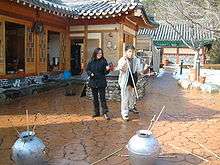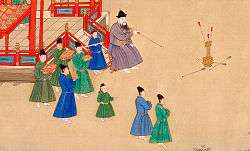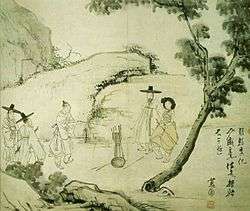Pitch-pot
Pitch-pot (Chinese: Touhu, Korean: Tuho, Japanese: Tōko) is a traditional East Asian game that requires players to throw sticks from a set distance into a large, sometimes ornate, canister. "Pitch-pot" is a literal translation of the two Chinese characters in the name (as in "pitch it into the pot"), and is used in Sinological literature.
| Pitch-pot | |||||||||
 Koreans playing tuho | |||||||||
| Touhu | |||||||||
|---|---|---|---|---|---|---|---|---|---|
| Traditional Chinese | 投壺 | ||||||||
| Simplified Chinese | 投壶 | ||||||||
| |||||||||
| Tōko | |||||||||
| Kanji | 投壺 | ||||||||
| Kana | とうこ | ||||||||
| Tuho | |||||||||
| Hangul | 투호 or 투호놀이 | ||||||||
| Hanja | 投壺 | ||||||||
| |||||||||
The game had originated by the Warring States period of China, probably invented by archers or soldiers as a pastime during idle periods.[1] The game began as a game of skill or a drinking game at parties, but by the time it was described in a chapter of the Chinese Classic Book of Rites, it had acquired Confucian moral overtones.[2] Initially popular among elites, it spread to other classes and remained popular in China until the end of the Qing Dynasty. During this time it also spread to Korea and Japan. Today, its popularity in Korea is highest.
As described in the Book of Rites

The following description is from the Book of Rites, following James Legge's translation.
1. According to the rules for Pitch-pot, the host carries the arrows in both his hands put together; the superintendent of the archery carries in the same way the stand on which the tallies were placed; and an attendant holds in his hand the pot.
2. The host entreats (one of the guests), saying, 'I have here these crooked arrows, and this pot with its wry mouth; but we beg you to amuse yourself with them.' The guest says, 'I have partaken, Sir, of your excellent drink and admirable viands; allow me to decline this further proposal for my pleasure.' The host rejoins, 'It is not worth the while for you to decline these poor arrows and pot; let me earnestly beg you to try them.' The guest repeats his refusal, saying, 'I have partaken (of your entertainment), and you would still further have me enjoy myself;--I venture firmly to decline.' The host again addresses his request in the same words, and then the guest says, 'I have firmly declined what you request, but you will not allow me to refuse;--I venture respectfully to obey you.'
The guest then bows twice, and signifies that he will receive (the arrows). The host wheels round, saying, 'Let me get out of the way;' and then at the top of the steps on the east, he bows to the guest and gives him the arrows. The guest wheels round, and says, 'Let me get out of the way.'
3. (The host) having bowed, and received the arrows (for himself), advances to the space between the two pillars. He then retires, and returns to his station, motioning also to the guest to go to his mat (for pitching from).
4. The superintendent of the archery comes forward, and measures the distance of the pot (from the mats), which should be a space of the length of two and a half arrows. He then returns to his station, sets forth the stand for the tallies, and with his face to the east, takes eight counters and stands up. He asks the guest to pitch, saying, 'When the arrow goes straight in, it is reckoned an entry. If you throw a second (without waiting for your opponent to pitch), it is not reckoned.' The victor gives the vanquished a cup to drink; and when the cups of decision have been dispatched, the superintendent begs to set up what he calls 'a horse' for the victor. If he set up one horse, then a second, and finally a third, he begs to congratulate the thrower on the number of his horses. He asks the host to pitch in the same way, and with the same words.
5. He orders the cithern-players to strike up 'The Fox's Head,' with the same interval between (each repetition of the tune), and the director of the music answers, 'Yes.'
6. When the superintendent announces to them on the left and right that the arrows are all used up, he requests them to pitch again. When an arrow enters, he kneels, and puts down a counter. The partners of the guest are on the right, and those of the host on the left.
7. When they have done pitching, he takes up the counters, and says, 'They have done pitching, both on the left and right; allow me to take the numbers.' He then takes the numbers two by two, and leaves the single counters. After this he takes the single counters, and gives the announcement, saying, "Such and such a side has the better by so many doubles, or naming the number of the singles.' If they are equal, he says, 'Left and right are equal.'
8. He then orders the cups to be filled, saying, 'Let the cup go round,' and the cup-bearer (of the successful side) replies, 'Yes.' Those who have to drink all kneel, and raising their cups with both hands, say, 'We 'receive what you give us to drink.' The victors (also) kneel and say, 'We beg respectfully to refresh you.'
9. When this cup has gone round, according to rule, (the superintendent) asks leave to exhibit the 'horses' (of the victorious side). Each 'horse' stands for so many counters. (He who has only) one 'horse' gives it to him who has two, to congratulate him (on his superiority). The usage in congratulating (the most successful) is to say, 'Your three "horses" are all here; allow me to congratulate you on their number.' The guests and host all express their assent. The customary cup goes round, and the superintendent asks leave to remove the 'horses.'
10. The number of the counters varies according to the place in which they kneel (when playing the game). (Each round is with 4 arrows.) (If the game be in) the chamber, there are 5 sets of these; if in the hall, 7; if in the courtyard, 9. The counters are 1 cubit 2 inches long. The neck of the pot is 7 inches long; its belly, 5; and its mouth is 2½ inches in diameter. It contains a peck and 5 pints. It is filled with small beans, to prevent the arrows from leaping out. It is distant from the mats of the players, the length of 2½ arrows. The arrows are made of mulberry wood, or from the zizyphus, without the bark being removed.
11. In Lû, the young people (taking part in the game) were admonished in these words, 'Do not be rude; do not be haughty; do not stand awry; do not talk about irrelevant matters; for those who stand awry, or speak about irrelevant matters, there is the regular (penal) cap.' A similar admonition in Hsieh was to this effect:--'Do not be rude; do not be haughty; do not stand awry; do not speak about irrelevant matters. Those who do any of these things must pay the penalty.'
12. The superintendent of the archery, the overseer of the courtyard, and the capped officers who stood by, all belonged to the party of the guest. The musicians and the boys who acted as attendants, all belonged to the party of the host.[3]
History of tuho in Korea

Tuho appears to have come to Korea from China during the Goryeo period, in 1116 CE, and was popularised by King Yejong. The king's patronage made the previously banned game into a popular courtly pastime, until the influence of the Yuan dynasty once again diminished tuho's popularity.[4]
In the fifteenth century, the Joseon dynasty revived the game at court, promulgating it as a creation of Confucianism. It was defended from criticism by King Jungjong in 1518, who reaffirmed its respectability and its Confucian connotations. Popularity at court enabled the game to spread through the scholarly and lay community, although the Sarim scholars of the Late Joseon period dismissed it as frivolous. Despite this tuho was a favourite pastime of the scholar Yi Hwang, who recommended it to his students as a way to develop physical health and mental focus. Tuho was featured (along with Yi Hwang) on the 1000 won note from 1983-2002, but was left off of the newest version of the 1000 won note which was first issued January 22, 2007.[5] It was also recommended by Jeong Yak-yong, in his Mongmin Simseo ("Admonitions on Governing the People").[4]
Arrow vases sometimes feature in the sculptural imagery of norigae accessories, where they symbolise the rejection of bad fortune.[6][7]
Tuho in Korea today
The game is a traditional diversion on Korean New Year's Day and Chuseok. Modern versions are often played with a simple canister and rubber-tipped arrows. The arrows used are usually between 50 and 60 cm long, and are thrown at the arrow vase from around ten paces away.[8] Tuho was also a popular drinking game.[9] For every arrow that missed the pot, the loser or bulseung (불승/不承, lit. no-success) had to take a drink.[9] To prevent betting on the outcome, losers could opt to sing a song as a penalty instead.[9] Players who did not miss the canister were called hyeon (현, lit. wise).[9]
References
- Asia Society, "Pitch-Pot: The Scholar's Arrow-Throwing Game," in Asian Games: The Art of Contest.
- G. Montell, "T'ou hu — the ancient Chinese pitch‐pot game," Ethnos 5/1-2 (1940): 70-83.
- James Legge. "Book XXXVII. Thau Hu or the Game of Pitch-pot." Sacred Books of the East, volume 28, pp. 397-400. Oxford: Oxford University Press, 1885.
- I-Hwa Yi (2006). Korea's Pastimes and Customs: A Social History. Homa & Sekey Books. pp. 85–86. ISBN 978-1-931907-38-5. Retrieved 18 March 2013.
- Ju Brown (7 September 2006). China, Japan, Korea: Culture and Customs. Ju Brown. p. 32. ISBN 978-1-4196-4893-9. Retrieved 19 March 2013.
- Kyung Ja Lee; Kyŏng-ja Yi (2005). Norigae: Splendor of the Korean Costume. Ewha Womans University Press. pp. 15–. ISBN 978-89-7300-618-2. Retrieved 19 March 2013.
- Kyŏng-ja Yi; Na-yŏng Hong; Suk-hwan Chang; Mi-ryang Yi (2005). Traditional Korean Costume. Global Oriental. p. 100. ISBN 978-1-905246-04-5. Retrieved 19 March 2013.
- Kim Ick-dal (1974). Korea: Its People and Culture. Hakwŏnsa. p. 293. Retrieved 19 March 2013.
- Ásfríðr Ulfvíðardóttir and Rebecca Lucas. "Tuho (투호, 投壺)". Medieval Korea website. Retrieved 20 May 2011.